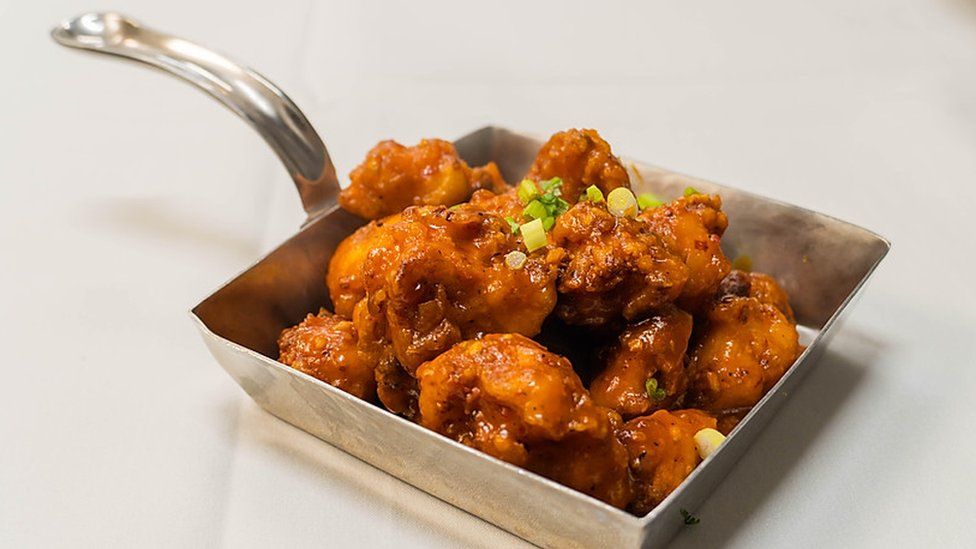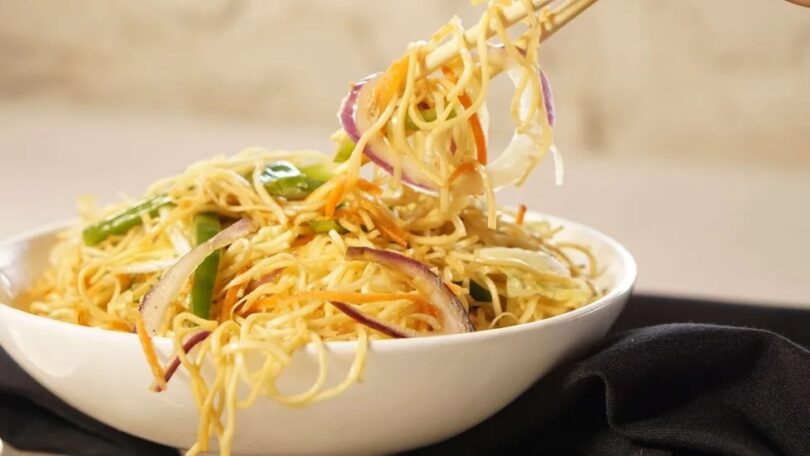Savita Patel
Indo-Chinese food – the sharp, spicy fusion between Indian and Chinese food – is now being spotted on many restaurant menus in the US. But what makes this comfort food of Indian immigrants such a hit?
Christina O’Neill clearly remembers when she had gobi (cauliflower) manchurian for the first time. It was at a friend’s home in an affluent Californian suburb in 2017.
The crisp, fried cauliflower florets dunked in a red chilli sauce “melted in her mouth” and quickly became her favourite.
“It’s an incredible medley of subtle spicy and sweet,” Ms O’Neill says.
She’s not the only one – across the US, at plush parties and downtown restaurants, the cauliflower manchurian and its variations have become a ubiquitous presence.
The dish is part of the distinctive Indo-Chinese cuisine, which has been around and wildly popular in India for decades.
The food is a bold mix of soy sauce, vinegar, garlic and ginger with an ample amount of chilli.
“It’s a creative incorporation of Chinese flavours with Indian ingredients,” says Abhilash, manager of the Georgia branch of Inchin’s Bamboo Garden, an Indo-Chinese speciality restaurant which has 25 outlets in North America.
Now, Indo-Chinese food can also be found in eateries across the US, which has a sizeable Indian-American population. While Indian and Nepali restaurants specialise in the fare, others have incorporated the signature dishes into their menus.
“People who’ve moved from India expect this from us,” says Anupam Bhatia, owner of Aurum and Broadway Masala in the San Francisco Bay Area.
“The tasteful fusion pairs well with white wine and makes Americans demand it too.”

Pastries, Biryanis & Chaat (PBK), a restaurant in Tampa, Florida, says it incorporated the cuisine after requests from its customers.
“Being near a university we get a lot of people from Asia and the Caribbean,” says Prasad Dasari, corporate chef and manager at PBK.
But what started as a response to satisfy the cravings of Indian immigrants has fast made its way into the American dining scene.
The cauliflower manchurian, for instance, has found a permanent spot on the menu. “It’s so popular that it’s difficult to take it off. And it sells as much as butter chicken,” Mr Bhatia says, referring to a popular sweet and spicy roast chicken preparation.
But the manchurian – which has no connection with the region of Manchuria – is just one among an array of Indo-Chinese staples that are on offer. Neha Sharma, the manager at San Ramon – a Californian branch of Inchin’s Bamboo Garden – says that the “most ordered” item on their menu is hakka noodles.
While its global recognition is a recent affair, the origins of Indo-Chinese food go back more than 100 years and lie in the Indian city Kolkata (formerly Calcutta).
In the 19th Century, thousands of Chinese migrants arrived for work in the city, which was then the capital of British India. The Cantonese migrants worked in carpentry and the ship-fitting industry, while the Hakka Chinese worked in the tannery and food business.
When they moved, they brought their food along with them. The first Chinese eatery was opened in the 1850s in what is now called the old Chinatown area of Kolkata, says Tathagata Neogi, an archaeologist who also organises history tours of the city.
“These were family-run, street-side eating places that catered only to the community,” he says. “Others rarely ventured there.”
On his tour, Mr Neogi shows participants the building which housed the first posh restaurant – Nanking – in the 1920s.
The place made the cuisine available to “those outside the small Chinese community for the first time”, he says.
“Governor Generals, viceroys and people in high society would dine there,” Mr Neogi explains.
As people developed a palette for Chinese food, the restaurant began adding more spices to the food and curating it to Indian tastes.
Soon more restaurants popped up in the city. By the 1960s, Chinese cuisine – once considered “exotic and expensive” – had reached street-side stalls in the form of chowmein and chops.
“That was called Indo-Chinese,” Mr Neogi says.
In 1961, the war between India and China pushed most of the Chinese immigrants out to the West. “Wherever they went – to the US, UK or Canada – they opened restaurants and started attracting the Indian diaspora,” Mr Neogi says.
For Kuang T Hou, the owner of an Indo-Chinese restaurant in New Jersey, the food is synonymous with his childhood – it’s what he grew up eating, he says.
A member of the Hakka Chinese community, Mr Hou’s family moved from India to Canada in the 1980s and then to the US.
“My in-laws ran Indo-Chinese restaurants in Calcutta for 35 years,” he says.
At his restaurant called Calcutta Wok, the best selling dishes are chilli chicken and cauliflower manchurian.
Apart from South Asians, Mr Hou says a “handful of adventurous Americans and Chinese customers” also visit.
“It’s new for them. Too spicy for some, so they ask for milder versions.”

What’s interesting is that despite its growing popularity, Indo-Chinese preparations are still absent from the thousands of Chinese restaurants in the US.
Jocelyn Chang, a second-generation Chinese-American in California, says her family would occasionally order momos, or steamed dumplings, from their neighbourhood Indo-Chinese restaurant.
“But we hadn’t even heard of dishes like cauliflower manchurian and chilly paneer.”
For Indian restaurants, however, the cuisine has become an indispensable part of their menu.
“Families come in wanting options for children. Small kids want noodles. That’s potential customers we didn’t want to lose out on,” Mr Dasari says.
Fifteen-year-old Shaurya Singh couldn’t agree more – he says he always looks forward to family drives to his favourite Indo-Chinese place in Nashville, Tennessee. “They have so much variety, there’s something for everyone.”
Mr Hou says that just about every Indian restaurant in the US now offers a few Indo-Chinese items. “It’s tasty. It sells. So people are cashing in on that.”
Courtesy: BBC







